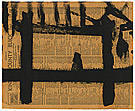Franz KLINE
Franz Rowe Kline was born on 23 May 1910 in Pennsylvania. He studied painting and drawing at Boston University from 1931 until 1935 and, the following year, drafting and illustration at the Heatherley School of Fine Art in London. In 1938 he returned to the United States and settled permanently in New York. In the early 1940s, Kline met Willem de Kooning and Jackson Pollock: two artists who were to have a significant influence on him, in particular, by encouraging him to experiment with new ways of gestural painting. His first solo exhibition, at the Egan Gallery, New York, in 1950, featured several large-scale black and white canvases; the exhibition established him as one of the leading Abstract Expressionist painters. Throughout the 1950s Kline held regular solo shows in New York, Boston, Chicago and, later, in Italy. By the end of the 1950s he reintroduced strong colour into his work.
Kline taught at the Black Mountain College in North Carolina, the Pratt Institute in Brooklyn, New York, the Philadelphia Museum School of Art and the Cooper Union for the Advancement of Science and Art, New York. His works were included in major international exhibitions including the Museum of Modern Art’s The new American painting in 1958, the 1957 São Paulo biennial and the Venice biennales of 1956 and 1960. In 1961 Kline was diagnosed with a rheumatic heart and died in New York on 13 May 1962. A memorial exhibition at the Washington Gallery of Modern Art travelled to Brandeis University and to Baltimore; a second memorial exhibition, organised by the Museum of Modern Art, New York, toured in Europe in 1963–64. An exhibition of his black and white paintings from the period 1950–61 travelled to several American venues in 1994–95.


